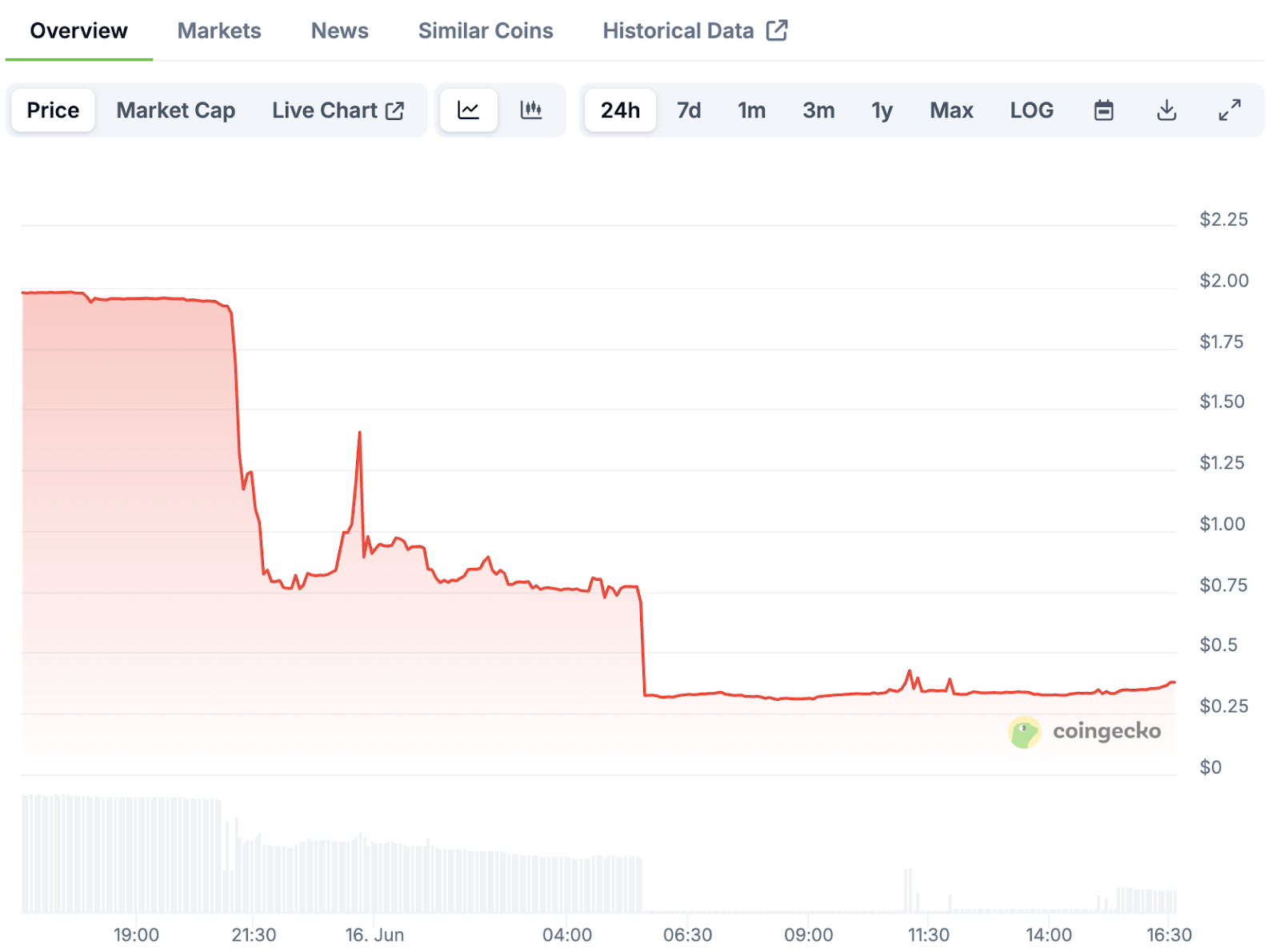In the past two days, blockchain project Polyhedra Network has experienced a dramatic collapse. Its native token ZKJ plunged to an all-time low of $0.3305, representing a 91% drop in a single day. The crash originated from a sudden liquidity crisis involving KOGE, a closely linked token, culminating in a dual-token liquidation spiral.

ZKJ token price crashes — Source: Coingecko
What Caused the Collapse?
According to an official statement from Polyhedra on X (formerly Twitter), the immediate trigger was the draining of the KOGE/USDT liquidity pool. Investors rapidly shifted to the ZKJ/USDT pool, which quickly became overwhelmed. Due to a shared liquidity mechanism between KOGE and ZKJ — with KOGE issued by 48 Club DAO and promoted via Binance’s Alpha Points incentive program — the prices of both tokens collapsed in a domino-like fashion. KOGE plummeted from $62 to $24, while ZKJ nosedived from $2 to $0.33.
On-chain data reveals suspicious behavior from large wallets prior to the crash. One address withdrew $3.7 million in KOGE and $530,000 in ZKJ, while two others pulled a combined $5 million. Analysts believe these exits directly triggered a cascade liquidation effect across the liquidity pools.
Worsening matters, 15.5 million ZKJ tokens are scheduled to unlock on June 19, potentially unleashing $10 million in new sell pressure at current prices. In response to the turmoil, Binance announced that starting June 17, mutual trades between Alpha tokens like ZKJ and KOGE will no longer count toward Alpha Points rewards.
ZKJ's Collapse Isn't Isolated — DeFi's Recurring “Stampede” Pattern
The ZKJ-KOGE meltdown echoes previous liquidity crises in the DeFi space:
Recurring Vulnerabilities:
While the ZKJ event may not rival the scale of LUNA or FTX, its mechanism of collapse is strikingly similar — revealing deeper, systemic weaknesses in DeFi design. Incentive-driven growth often masks poor liquidity quality, weak governance, and inadequate risk control.
Binance Alpha Incentives: From Innovation to Exploitation?
The Binance Alpha Points program, launched in 2024, aims to reward early ecosystem participation. Users accumulate points through trading volume, liquidity contribution, and on-chain activity — with the promise of future premium token airdrops.
The idea is to quantify user contribution in early projects like KOGE and ZKJ, encouraging genuine participation and holding. However, the lack of clear rules, anti-abuse safeguards, and adaptive governance has opened the door to exploitation.
Case in Point: KOGE & ZKJ
Traders discovered they could frequently switch between KOGE and ZKJ to farm Alpha Points, with no long-term commitment to the projects. Because of the tokens’ low liquidity, even small capital injections triggered sharp price movements — creating the illusion of high activity.
Just before the crash, multiple whale addresses executed high-volume token swaps, suspected of “point farming,” followed by mass withdrawals exceeding $8 million. This directly drained the ZKJ/USDT and KOGE/USDT pools, triggering the price collapse.
What was intended as a user-governed incentive system has become a speculator’s playground, highlighting the risk of poorly managed reward designs in DeFi.
Binance’s Endorsement No Longer a Guarantee of Safety
In previous years, being featured by Binance — whether through Launchpool, the MVB program, or Alpha Points — was a signal of project legitimacy. But as mechanisms like Alpha Points get exploited and liquidity unravels, investors are reconsidering the weight of Binance’s endorsement.
What Is ZKJ?
ZKJ is the native token of Polyhedra Network, a project focused on privacy and scalability via zero-knowledge proofs (ZKPs). ZKJ functions as both a utility token for gas and a governance token for protocol decisions. It also shares liquidity and reward systems with related tokens like KOGE, as part of Binance’s incentive ecosystem.
Though a full whitepaper is pending, ZKJ’s token distribution is roughly outlined as follows:
Final Thoughts
Polyhedra Network has stated it is investigating the event and that its underlying technology remains sound. However, this liquidity storm serves as a stark reminder: even robust tech can’t shield projects from systemic fragility when governance, incentives, and liquidity mechanics fall short.
For developers, platforms, and investors alike, sustainable DeFi growth must be rooted in transparency, discipline, and real utility — not incentive arbitrage or speculative bubbles. Volatility may be forgiven; complacency and blind trust will not.
原文: 《 ZKJ and KOGE Tokens Plunge Amid Liquidity Crisis and Binance Incentive Fallout 》
免责声明:本文章仅代表作者个人观点,不代表本平台的立场和观点。本文章仅供信息分享,不构成对任何人的任何投资建议。用户与作者之间的任何争议,与本平台无关。如网页中刊载的文章或图片涉及侵权,请提供相关的权利证明和身份证明发送邮件到support@aicoin.com,本平台相关工作人员将会进行核查。




